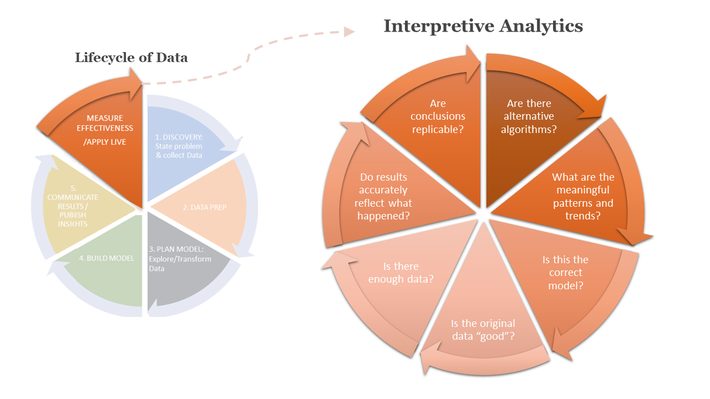- Interpretive analytics (IA) takes you beyond number crunching.
- AI is the key to getting involved in strategic decision making.
- Strategies for using interpretive analytics in one picture.
The final step in the lifecycle of data moves data from the sandbox into a live environment. Data is monitored and analyzed to see if the generated model is creating the expected results. How you analyze the model is what interpretive analytics is all about; While data analysis is about analyzing the problem, interpretive analytics is about interpreting the outcome and telling a story. Interpretive analytical reporting can have a big effect on an organizations bottom line and reveal trends in cost centers, entities, and portfolios. [1] It can study data-mining algorithms and suggest alternate routes [2].
With interpretive analytics, the focus shifts from the quantitative (numerical) to the qualitative (non-numerical), asking questions like:
- What does this mean?
- Where did the data come from?
- What happened?
- Are there any meaningful patterns or trends?
Even if you have access to interpretive analytics based on dashboard accessible real time data, its still useful to look under the hood and see how any conclusions were drawn. If you dont have access to that technology, then knowing what to look for in your interpretations is a must. A few key areas to consider:
- Look over your original data to see if the result was as you expected. Did you choose the correct model and run the right regression?
- Did you use enough quality data? If youre making predictions to a larger population, make sure your sample size was big enough and that you used good data.
- Do your results accurately reflect what happened? Look out for cherry picking, where your own biases might have caused you to paint a rosier (or bleaker) picture than is warranted.
- Are your conclusions replicable? In other words, would a colleague likely come to the same conclusion as you? If youre not sure, have a second pair of eyes jump in and double check your results, your analysis, or both.
There are many challenges with applying interpretive analytics [3], especially if you dont have access to AI or a dashboard that can do the job. As these techniques are not purely data-driven, they are more prone to personal bias and subjective interpretations, although careful and methodical analysis of the data might make bias less likely.
Another issue is that your interpretations are based on data-driven conclusions from numerical data analysis. If your original data isnt properly cleaned, blended or formatted might lead to disastrous interpretive outcomes. Ensure that your data is good and that your data analysis methods are sound before running any interpretive analytics. Your organization will thank you.
References
Image by author.
[1] Optimizing health care property portfolios Accessing data and analy…
[2] Why Most Business Intelligence Projects Fail?
[3] Facilitating the Exploration of Open Health-Care Data Through BOAT:…

